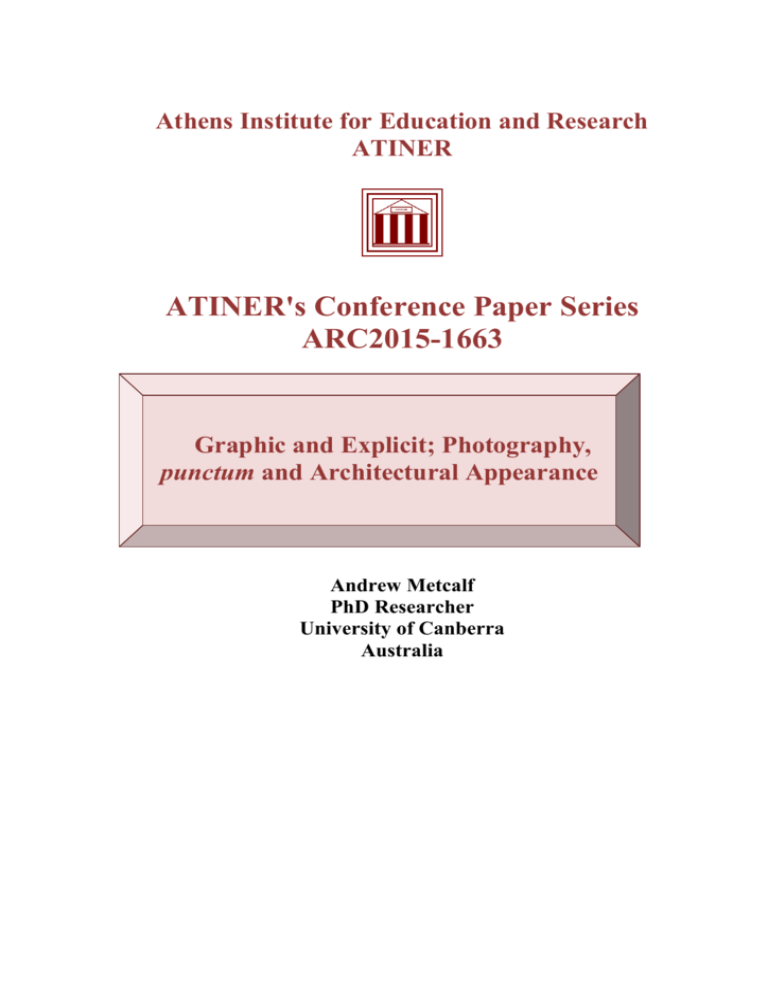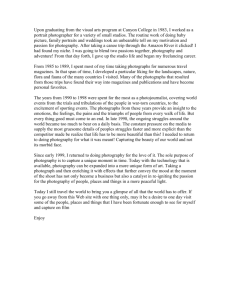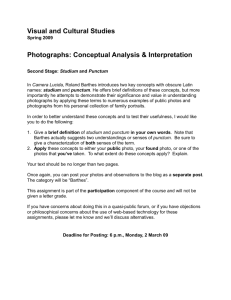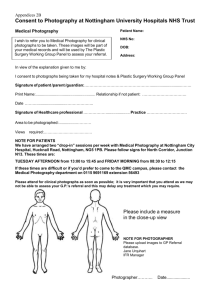
ATINER CONFERENCE PAPER SERIES No: LNG2014-1176
Athens Institute for Education and Research
ATINER
ATINER's Conference Paper Series
ARC2015-1663
Graphic and Explicit; Photography,
punctum and Architectural Appearance
Andrew Metcalf
PhD Researcher
University of Canberra
Australia
1
ATINER CONFERENCE PAPER SERIES No: ARC2015-1663
An Introduction to
ATINER's Conference Paper Series
ATINER started to publish this conference papers series in 2012. It includes only the
papers submitted for publication after they were presented at one of the conferences
organized by our Institute every year. This paper has been peer reviewed by at least two
academic members of ATINER.
Dr. Gregory T. Papanikos
President
Athens Institute for Education and Research
This paper should be cited as follows:
Metcalf, A. (2015). "Graphic and Explicit; Photography, punctum and
Architectural Appearance", Athens: ATINER'S Conference Paper Series, No:
ARC20151663.
Athens Institute for Education and Research
8 Valaoritou Street, Kolonaki, 10671 Athens, Greece
Tel: + 30 210 3634210 Fax: + 30 210 3634209 Email: info@atiner.gr URL:
www.atiner.gr
URL Conference Papers Series: www.atiner.gr/papers.htm
Printed in Athens, Greece by the Athens Institute for Education and Research. All rights
reserved. Reproduction is allowed for non-commercial purposes if the source is fully
acknowledged.
ISSN: 2241-2891
27/10/2015
ATINER CONFERENCE PAPER SERIES No: ARC2015-1663
Graphic and Explicit;
Photography, punctum and Architectural Appearance
Andrew Metcalf
PhD Researcher
University of Canberra
Australia
Abstract
Observing a century of relations between architecture and photography in the
use of graphic, drawing and photographic practices, this paper follows some
conceptual transactions between the two disciplines. Primarily, there is an
essential difference however; in a given situation, photographers will seek to
capture what is, whereas architects often work to formulate what can be. Over
time, there has been a convergence of thinking and practice between the two
disciplines, notably on the part of architects such as Neil Denari whose
thinking reflects certain practices of photographers like Andreas Gursky and
Jeff Wall. In examining these occurrences, it is relevant to note Roland Barthes'
critical insight of the binary pair he called the studium and punctum to visualize
a cohesive overall background coupled with a specific element occurring in
photography, and by inference, in architecture, especially at the conceptual and
representational moment.
Keywords: Architecture, Barthes, concept, Denari, drawing, graphic design,
photography, punctum
3
ATINER CONFERENCE PAPER SERIES No: ARC2015-1663
The relationship of architecture and photography is close. Just as
architecture provides enduring photographic subject matter, architectural
schemes are now becoming imbued with photographic form as architectural
conceptualizing draws on the aesthetics of photography. Decades before the
development of digital image manipulation technology, architects discovered
photo-montage and photographic composition. Now, some architects view
practices deriving from photographic theory and technique as exemplary
models for architectural production itself. Prior to the turn of the current
century, it probably would have seemed unimaginable that works in
architecture and photography would be created digitally. In a certain way the
two disciplines now constitute a mirrored pair, they tend to overlap and even
hybridize. This phenomenon is such that buildings can now look as if they've
been created digitally and architectural renders can appear distinctly
photographic and not "drawn" at all. Talking about this situation, Philip
Ursprung1 suggested this convergence had now reached a point where: "… the
architecture of the photograph and the photograph of the architecture merge
and can no longer be clearly separated from one another." The pictorial
anticipation of an architectural proposal now encompasses extensive use of
digital techniques marshalled from both architecture and photography. Over the
last fifteen years, the role photography has come to play in architectural image
formation is inestimable. However, even though it’s possible to talk of
hybridism there is still a viable demarcation between photographer and
architect.2 The photographer's intention is to capture: "… the moment like a
seismograph" whereas "… the architect is …trained to think about what could
be there." Although the story of how this has happened and what might come
next is undocumented, the conversations have started3.
My intention in this essay is to reflect on the core of 20th century
architectural, photographic and drawing practices that are germane to the
current situation. I will also discuss the work of Neil Denari, as an instance of
an architect receptive to photographic possibilities. Those core features are: the
differences between the human eye, the "photographic eye"; the creative
correlations between architects and photographers; architectural image
formation in first half of the century; Roland Barthes' construal of the studium
and punctum in photography; composition and uncanniness; and, the work of
narrative photographers Gregory Crewdson and Jeff Wall. Since emerging in
the 1990s with intense architectural delineations of striking graphic quality,
Denari has gradually moved to an architecture-to-photographic parallelism in
his projects which places him in the middle of the digital architecturephotography association.
The visual language of architecture and photography are dissimilar. In a
perceptual sense, photographs transform architectural volume into surface and
1
Ruby, I.&A, and Ursrpung, P. (2004) p.4
www.philippschaerer.ch
3
Ruby, I & A, and Ursrpung, P. (2004) and Janser, D. (2013)
2
4
ATINER CONFERENCE PAPER SERIES No: ARC2015-1663
distil matter and shadows into forms4. However, it is in the nature of
photography to capture architecture quite differently from the way a human eye
does. Camera lenses are optical instruments that offer view angles and a
sensibility to light exceeding that of the eye. However, cameras can't see all
those views simultaneously as the eye can and have a smaller dynamic range
(i.e. record both highlight and shadow in great detail) than does the human eye,
although technology has breached that gap to some extent as the work of
contemporary photographers shows. An important consequence of these
differences is that photographic devices come between us and what we see in
various ways. Firstly, looking into a camera immediately alerts us to the fact of
framing the picture, where something is in the frame and everything else is
excluded. This doesn't happen with the eye of course. Secondly, the eye, which
has a nominal focal length of 50mm (equal to that of a standard, full frame
lens), can see - or give the impression of seeing - a complete range of focal
lengths whereas camera lenses, only see one focal length per image capture.
Habituated as we are to viewing architecture through the medium of
photography, we are only dimly aware of the self-deception these constraints
engender when we think of photographs as a stable record. A photograph, that
seismographic instant, does indeed capture the moment but it is that moment
and no other. In photographs, we access one specific way to see, while our eyes
see much more and differently.
Photographs and drawings are both depictive mediums where
photography's capability to capture form relates to that of a drawing. Until
recently, drawings were the principal pre-construction depictive medium for
the presentation of architectural ideas whereas photographs were the depictive
media used for recording buildings, the final form of architectural ideas. So,
even though photography originally came to architecture post-construction,
that too has changed as it now tends to dominate the pre-construction depiction
of architecture. Interestingly, that change began a century ago as the depictive
practices of drawing, collage and photomontages evolved under the influence
of photographic precepts.
4
Janser, D. (2013). p.10
5
ATINER CONFERENCE PAPER SERIES No: ARC2015-1663
Figure 1. Wright, FL (1902-06) Larkin Building, Buffalo NY. Drawing by H
Klumb (1929)
Image Courtesy of the Frank Lloyd Wright Trust
For example, it's astonishing how progressive graphic visualizations such
as Frank Lloyd Wright's view (Figure1) of the Larkin Building (Buffalo, 190206) anticipated the mid 20th century standard of the wide angle, high contrast
architectural photograph decades before it happened. The clear-cut black ink
drawing and perspective distortion valorise the building to a high level. Wright
used this type of drawing infrequently, presumably for certain publication
situations, so it could be deemed a minor mode compared to the larger corpus
of his drawings. Ludwig Mies van der Rohe, on the other hand, developed a
progressive trajectory with his presentation artwork and refined it continuously.
From the 1920s to the 1950s he used new photographic techniques such as
photomontage and photo-collage to literally "construct" architecture on paper.
In his montage renders the presence of photography gradually increased in
significance as the images evolved from just drawn content to virtually total
photographic content. This metamorphosis starts with the Friedrichstrasse
Skyscraper Project drawing (1921) and ends the Chicago Convention Hall
project (1953), the interior rendering of which is an assemblage of
photographic images entirely. The 1926 Alexanderplatz proposal, the 1939
Resor House, the 1947 IIT Campus proposition belong to the three decade
6
ATINER CONFERENCE PAPER SERIES No: ARC2015-1663
sequence. It is clear that, without photography, these images would not exist
and it is also likely that few leading architects would have used photography
this extensively in those decades.5
At the same time, in commissioning photographers Hedrich-Blessing,
Balthazar Korab and Ezra Stoller to record built work, Mies didn't abandon
traditional architectural photography at all. Alluding to the epic photographic
tradition in 1995, Ignasi de Sola-Morales6 articulated the difficulty we have in
separating our interpretation of modern architecture from the iconic
photographs that standardize access to the canonical works. An archetype of
the transactions between architect and photographer that generates SolaMorales' dilemma subsisted between Richard Neutra and Julius Shulman over
three decades from 1936 (Figure 2). They both brought value to the affiliation
which made it possible to influence one another’s creative practice. Just as
Neutra’s architecture unquestionably fostered Shulman’s images, those images
furnished the architect with a fresh way of seeing which fed into his
architectural thinking.
It's hard to imagine Neutra without Shulman and vice versa. Interviewed
later in life,7 Shulman struggled to explicate his photography and lapsed
somewhat to a recitation of technique noticeable for its absence of theoretical
content.
Figure 2. Shulman, J. (1947) Kaufman House, Palm Springs, California
Image Courtesy of J. Paul Getty Trust. Getty Research Institute, Los Angeles
5
Riley, T., & Bergdoll, B. (2001)
De Sola-Morales, I. (1995)
7
Rosa, and Shulman. (1994)
6
7
ATINER CONFERENCE PAPER SERIES No: ARC2015-1663
Modern photographic theory appears to have flourished with the impact of
the Bauhaus photography program and seminal essays such as Walter
Benjamin's A Small History of Photography.8 By the early 1980s, the field had
expanded to include the classic Roland Barthes essay Camera Lucida, a
meditation on form, content and meaning in photography. 9 Looking at, and
thinking about photographs after his mother's death, he noted that all
photographs are of something that has been but is no longer there - something
that is already dead. Architectural photographs are of a like nature: the moment
of the photograph, which architectural photographers sometimes call the "zero
hour," is artificial in that it is immediately gone and beyond recovery. Further,
with the passage of time, photographs become archival documents and hence,
part of history. Barthes comments: “… I can never deny that the thing has been
there. There is a superimposition here: of reality and the past. And since this
constraint exists only for photography, we must consider it, by reduction, at the
very essence … of photography".10 In Camera Lucida Barthes also mulled over
two phenomena, which he called the studium and the punctum, to be found in
photographic images. For him, the studium is the main visual form or dominant
image substrate which is almost, but not quite, the background and the punctum
is the thing which unhinges and disrupts the studium.
Barthes instanced this in a war picture by Koen Wessing where the
studium comprises three soldiers patrolling a barricaded Nicaraguan street and,
behind them, two nuns cross that same street and provide the punctum. Tension
is evident. As Barthes says: "To recognise the studium is inevitably to
encounter the photographer's intentions, to enter into harmony with them."11
The studium/punctum relationship generates a key part of image composition
and meaning. Of course, image composition is something architecture and
photography have in common. In architecture, it characteristically arises amid
associated forms with the punctum allocated to an essential part of the
program. In architectural photography it can occur in the residual space
between forms. In this Wolfgang Sievers12 picture (Figure 3) two perspectival
forms rise through the frame - one light, one heavy, one in silhouette, the other
not. The eye is drawn to the space between them.
8
Benjamin. (1979)
Barthes. (1982)
10
Barthes (1982) pp.76-77
11
Barthes (1982) pp.27-28
12
Sievers, (1997)
9
8
ATINER CONFERENCE PAPER SERIES No: ARC2015-1663
Figure 3. Sievers, W (1965) Royal Insurance Building, Collins Street,
Melbourne
Image Courtesy of National Library of Australia
In another manner, photography’s facility to stimulate formal insights into
architecture is exemplified in Edward Burtynsky's work13documenting the
Bangladesh ship-breaking and recycling industry wherein large vessels are
broken down into sections the size of large architectural constructions. There is
a startling blend of the familiar and the unfamiliar in such weird, deconstructed
assemblages that are simultaneously ship-like and building-like. They are an
uncanny transmutation of Corbusier’s14 ocean liner archetype of the 1920s.
"The uncanny," Johannes Binotto explains, is: "… not just the opposite of the
familiarity of being “at home”, but is the moment at which the seemingly
familiar turns out to be unfamiliar, while, conversely, the seemingly unfamiliar
unexpectedly appears familiar."15 Current pre-occupations with uncanniness in
photography make it tempting to think that the phenomenon is more endemic
in photography than architecture. However, this imbalance could be of the
present and may change, particularly as the range of available digital tools and
effects increases in architecture. Significantly, there is an historical discourse
on architectural uncanniness instanced in Anthony Vidler's 1992 study16 of the
"unhomely" for example and, added to that, there is Neil Denari's orientation to
the "reality distortions project" which is of the moment.
13
Burtynsky. (2000)
Le Corbusier. (1976) pp. 87-97
15
Binotto. (2013)
16
Vidler. (1992)
14
9
ATINER CONFERENCE PAPER SERIES No: ARC2015-1663
Figure 4. Crewdson, G (1999) Untitled
Image Courtesy of Solomon R. Guggenheim Museum, New York
Evidence of the uncanny in photography resides in the much published and
exhibited work of Gregory Crewdson (Figure 4) who constructs still pictures in
a manner that reflects the mise-en-scene ("placing on stage") practice
belonging to the theatre and motion pictures. Using scripts, actors and
elaborate lighting to generate scenes for his large-format still camera he
fabricates and narrates circumstances in an imaginary suburban world. In
Crewdson's pictures the implied narrative is one in which it appears as if
something has just happened … or is about to happen.
The Canadian Jeff Wall’s photographs also enable stories to be
constructed. He explains17 that he works to pre-figure his pictures by initially
"… not taking a picture - that comes later." Reflecting on parallels his process
has with film making including pre-visualisation and scripting, he says: "In
film, people have to prepare a lot of things - working with performers,
inventing spaces that haven't existed before, adapting equipment etc. I want to
create a plastic sequence and bring it to a conclusion somehow." Elsewhere we
confront what he calls a "… aura of mystery asking questions such as: is this
the moment before or after; who is the woman; where is she going; and what's
under the cloth?" Wall, who Herzog and de Meuron have commissioned to
photograph a project, has also explored Mies van de Rohe's Barcelona
Pavilion. His Morning Cleaning (1999)18 shows a cleaner at work in the
building. In this picture, which has circulated widely in architectural circles,
the punctum is the solitary figure in the midst of Mies’ architecture. Our
attention is drawn to the human figure. Wall, who is also an art historian, may
17
Wall. (2012)
It is actually a combination of two photographs taken from the same viewpoint - one exposed
for the exterior and the other for the interior. Then, using Photoshop, they've been blended into
one, thus replicating the dynamic range of a human eye.
18
10
ATINER CONFERENCE PAPER SERIES No: ARC2015-1663
well have done so with the intention of furnishing a trace of one of those
personages Michel Foucault called " … those billions of existences which are
destined to pass away without a trace" 19.
Figure 5. VW Logo and Half-Timbered House
Image Reconstructed by A. Metcalf
In a 200820 lecture espousing photographic metaphor, Neil Denari showed a
VW logo beside a monochromatic axial photograph of a half-timbered German
dwelling saying: "If on the one hand the Volkswagen logo is about a
commercial, global world, it's also about a technique which is about trying to
burn an image into one's eye." He continued that the half timbered façade
works in the same optical way as the logo saying: " In terms of messages that
they send, one is about offering a super graphical way of talking about
structure, and the logo is about graphic, high contrast resonance. We'd like
our work to borrow from both these paradigms." Further, he records an
ambition to get, what he calls, "the Gursky effect" into his renders and
buildings, referring to the work of the famous German photographer whose
images are known for their graphic potency.
19
20
Foucault. (1979)
Denari. (2008)
11
ATINER CONFERENCE PAPER SERIES No: ARC2015-1663
Figure 6. Denari, N (2005-12) HL-23, Exterior/Interior, New York
Image Courtesy of Neil M. Denari Architects
Denari's HL23 Apartment Building (2005-12, New York)21 delivers on
that avowed intention (Figure 6): it is what he calls a "graphical project" with
an internal steel structure sitting inside a glass façade albeit with the structural
frame redrawn as a frit on the curtain walling. Shortly after the building
opened22 he spelt out a recurring axiom for himself to "… make it graphic and
explicit, which is essentially … to talk about the explicit in architecture which
is artifice, but also a real signifier." Denari doesn't talk of the uncanny, but of
creating "reality distortion" projects (alluding to the Reality Distortion Field
effect at Apple in the 1980s where engineers worked hard on their ideas only to
find the best ended being Steve Job's big idea). Denari is also interested in Jeff
Walls' pre-figuration of his pictures, and Gregory Crewdson's intricately
planned "construction" of photographs using story-boards, sets, lighting and
actors23. In all this Denari, looks to expand architecture's field of referentiality
to include that which is graphic and high-impact - not to mention scripted and
structured like a movie (Figure 7). His is also a prescription that abrogates the
architectural default strategy of merely "… holding a mirror up to the world."
21
Denari. (2013). pp.100-09.
Denari, and Mayne (2012).
23
Denari. (2014).
22
12
ATINER CONFERENCE PAPER SERIES No: ARC2015-1663
Figure 7. Denari, N (1999) Vertical Weekly Mansion, Tokyo
Image Courtesy of Neil M. Denari Architects
Over time, this architect's trajectory has moved from 1990s drawn fictions
to digitally created, graphically overt built works with a consistent mise-enscene like use of pre-figuration and photo-simulation techniques. He has
produced images that are like photographs and built works that strive to reach
the graphic force of photographic works. Photographers talk about making a
picture, not merely taking a picture; Denari draws on this trans-disciplinary
sentiment when he tackles the imagining, inventing and constructing of
architectural projects. Reversing Roland Barthes' "... a photograph is always of
something that-has-been," Denari follows a path of working to represent and
build architecture that has never been but will be. At this point it is pertinent to
recall Barthes' studium/punctum dialectic in photography to make sense of a
cohesive overall background coupled with a specific element which pointedly
disrupts it. Denari's current architecture foregrounds graphic punctum to
observable effect (Figure 8). One way of reading his architecture would be to
subject it to an equivalent analysis.
A century after its inception photography’s visual properties showed up in
architectural drawing practices, as the 1920s work of Mies van der Rohe
attests. Whilst this was most evident in the presentation of architect’s designs
for most of the remaining century, in this century, photographic aesthetics and
digital realisation are becoming established in the conceptualisation of
architecture as well as its presentation. The architecture of Neil Denari and
others illustrates this tendency.
13
ATINER CONFERENCE PAPER SERIES No: ARC2015-1663
Figure 8. Denari, N (2017 projected) New Keelung Harbour Service Building,
Taiwan
Image Courtesy of Neil M. Denari Architects
References
Barthes, R. (1982). Camera Lucida: Reflections on photography. London: Jonathan
Cape.
Benjamin, W. (1979). A Small History of Photography. In One-way street, and other
writings (Pbk. Ed.). London: NLB.
Binotto,J. (2013). The Other Scene: On the Uncanny Architecture of Photography. In
Concrete: Photography and architecture (pp. 228-231). Scheidegger & Spiess.
Burtynsky, E. (2000). Edward Burtynsky SHIPBREAKING Web Gallery. Retrieved
May 11, 2015, http://edwardburtynsky.com/site_contents/Photographs/Shipbrea
king.html
De Sola-Morales, I. (1995). Terrain Vague. Anyplace, 118-123.
Denari, N. (1999). Gyroscopic Horizons. New York, N.Y.: Princeton Architectural
Press.
Denari, N. (2008). "The New Intimacy" Syracuse University School of Architecture
Lecture, 03 Oct 2008. Retrieved May 11, 2015, from https://www.youtube.com/
watch?v=fy-4Z75_Dtk
Denari, N. and Mayne, T (2012) A.UD Lecture Series 2009-2010: Neil Denari and
Thom Mayne in Conversation (2012, February 19). Retrieved May 11, 2015,
from https://www.youtube.com/watch?v=VMJMHikk_o0
Denari, N. (2013). HL23. Log #29, 100-109.
Denari, N. (2014). Reality Distortion Field: Spring 2014 Baumer Lecture Series #3.
Retrieved May 11, 2015, from https://www.youtube.com/watch?v=LCIcX0ax
H7U
Foucault, M. (1979). The Life of Infamous Men. In Michel Foucault: Power, truth,
strategy (pp. 76-91). Sydney, Australia: Feral Publications.
Gursky, A., & Rgi, B. (2007). Andreas Gursky: Kunstmuseum Basel. Ostfildern: Hatje
Cantz.
Janser, D. (2013). Concrete: Photography and architecture.
rich: Scheidegger &
Spiess.
14
ATINER CONFERENCE PAPER SERIES No: ARC2015-1663
Le Corbusier, L. (1976). Towards a new architecture (Repr. Ed.). London:
Architectural Press.
Riley, T., & Bergdoll, B. (2001). Mies in Berlin. New York, NY: Museum of Modern
Art.
Rosa, J., & Shulman, J. (1994). A constructed view: The architectural photography of
Julius Shulman. New York: Rizzoli.
Ruby, I., & A, and Ursrpung, P. (2004). Images: A picture book of architecture.
Munich: Prestel. Schaerer,
Schaerer, P (n.d.). Retrieved May 11, 2015, from http://www.philippschaerer.ch
Sievers, W. (1997). Wolfgang Sievers. Neutral Bay, N.S.W.: Writelight.
Vidler, A. (1992). The architectural uncanny: Essays in the modern unhomely.
Cambridge, Mass.: MIT Press.
Wall, J. (2012) "AGWA Talks: Jeff Wall." https://www.youtube.com/watch?v=zq
MoXMyEStU. Accessed May 11, 2015.
15









